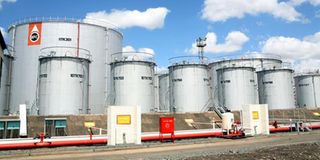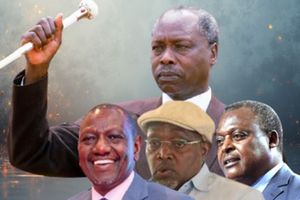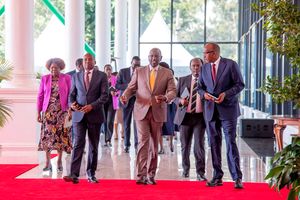Premium
How Sh42 billion Kenya Pipeline deal was stopped days to election

Oil storage tanks at the Kenya Pipeline Company in Nairobi.
It’s a gripping tale about the lengths to which greedy elites will go to squeeze money out of cash-rich parastatals, especially in the build-up to a general election when they are surrounded by uncertainty and prospects of imminent regime change.
The Weekly Review has seen documents showing how – towards the end of the regime of former President Uhuru Kenyatta – the National Treasury crafted a bizarre scheme to irregularly raise a whopping Sh42 billion from the state-owned Kenya Pipeline Company.
In a nutshell, the transaction was structured as follows: You force a parastatal that you own 100 per cent to borrow billions from a syndicate of banks to purchase another asset that you also own 100 per cent, and in the process, raise billions of shillings for the exchequer. Indeed, KPC was being forced by the National Treasury, its shareholder, into buying the Changamwe-based Kenya Petroleum Oil Refineries Ltd, whose facilities have been under its management under a lease arrangement since March 2017.
Documents seen by The Weekly Review show that stakes had been so high that former National Treasury Cabinet Secretary, Ukur Yatani, personally took charge of the transaction and would at some stages personally attend board meetings of KPC as he strenuously and laboriously scrambled to unlock the irregular transaction by forcing a board resolution. Cabinet Secretaries rarely attend board meetings of parastatals.
This was clearly an irregular transaction in many ways. Consider the following: You buy non-revenue generating assets that you already own with borrowed money, and dump a huge liability with third-party banks on the books of KPC, a company you owned at the beginning of the transaction.
But even more controversial was the valuation the National Treasury was scrambling to force through a resolution of the KPC board. According to correspondence in our possession, the Sh42 billion valuation that the National Treasury was hurriedly forcing through was conducted by the Ministry of Lands and Housing. It begs the question: Where is transparency in a transaction where the government is buying an asset it already owns on the basis of a valuation conducted by itself? Where is arm’s length and how do you buy an asset at a price you have decided by yourself?
We have seen correspondence showing that the CEO of KPC, Dr Irungu Macharia, wrote to the National Treasury informing the company’s sole shareholder that in the corporation’s own assessment, the assets deemed useful from a business perspective were valued at a figure much lower than the government’s Sh42 billion valuation.
KPC insisted on a valuation of Sh19 billion for KPRL’s assets that it deemed useful for its business.
But the clearest indication that the transaction that the National Treasury was trying to force on KPC was dodgy and bizarre was to emerge in a report by the financial services advisory group, PricewaterhouseCoopers Ltd (PWC), a copy of which has been seen by The Weekly Review.
In brief, PWC’s assessment of the transaction was as follows: This asset is yours and KPC can get it for free by transferring the shares at a paper con value. PWC’s conclusion was sensational, considering that the National Treasury was almost succeeding in forcing KPC to take up a loan of US$400 million to pay for the assets of KPRL.
PWC’s valuation of land, buildings, tanks and pipe works, and a captive power plant also came to a mere Sh17.9 billion, which was a much lower figure when compared with the government’s valuation of Sh42 billion.
What comes through from the correspondence is that the National Treasury was adamant about proceeding with the Sh42 billion valuation. Indeed, the National Treasury approval for KPC to borrow the large amount had been given as far back as December 1, 2021. “The purpose of this letter is to grant you approval to borrow Sh42.6 billion and to refinance the existing facility,” said Yatani in a letter to KPC.
Is it not the height of irony that the National Treasury was planning to saddle KPC with this massive dollar loan despite the fact that the company was at that time still in the middle of servicing a massive US$350 million loan it had borrowed in 2015 to construct a 20-inch diameter pipeline from Mombasa to Nairobi? As the pressure on KPC to borrow the money mounted, the company wrote to Standard Chartered Bank of the UK – the mandated lead arranger in the existing dollar loan – to ask for the money. “We are seeking to refinance the existing facility, which stands at a balance of US$149.9 million as at December 2021, as well as raise additional funding of Sh42.6 billion to be utilised for acquisition of the KPRL facility,” said the company in a letter dated December 17, 2021.
What saved KPC from this dodgy transaction that was going to saddle the company with massive loans? Clearly, the change of the regime following the advent of President William Ruto’s administration in 2022 was a major factor. Pockets of resistance against the deal from within the board of the company were also an important contributory factor. Documents show how the board at one point insisted that the borrowing of the money be delayed until thorough due diligence of KPRL and a comprehensive business case for the acquisition had been conducted
The board also insisted on an independent report by the PWC report on the best take-over options. As it turned out, term sheets from the financiers and lenders did not come through until January, 2021.
The lenders also spelt out conditions that included appointment of an independent transactions adviser. The procurement of an independent adviser did not happen until April 2022. With the General Election approaching in a few months and a change of regime imminent, the National Treasury found itself without the political muscle to push through the unpopular and dodgy transaction.
KPRL has 45 tanks with a total storage capacity of 484 million litres, out of which 254 million litres is reserved for refined products while the remaining 233 million litres is reserved for crude oil. The thinking was that these facilities would provide additional storage capacity for KPC, which would unlock supply chain bottlenecks in Mombasa and save oil marketing firms millions of dollars paid on demurrage charges to shipping companies.
KPRL also has about 370 acres of underutilised land at the port which KPC intended to use to construct storage facilities, including for LPG.





